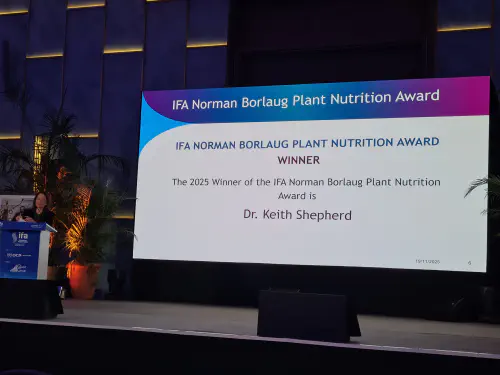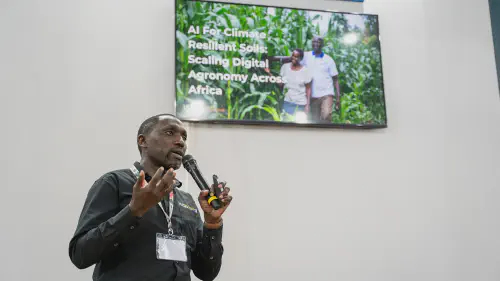A Product Manager’s Perspective on the Future of African Agriculture
AI and agronomy are powerful forces in transforming smallholder agriculture. But without strong product leadership, the benefits can remain out of reach for farmers.
At iSDA, Emmanuel Gyampo plays that connecting role. As Product Manager for Virtual Agronomist, he brings together agronomists, data scientists and farmers — helping translate complex models into simple, actionable advice farmers can trust. In this interview, Emmanuel shares how he bridges these worlds to make data-driven farming work on the ground.
Q: Emmanuel, your background spans product strategy, business development and digital platforms. What drew you to iSDA and to product management in agriculture?
I come from a rural community and grew up around farmers. One of my early ambitions was to own a farm myself. When the opportunity to work with iSDA came up, I had already started an agribusiness — buying vegetables from farmers and supplying them to malls. With my background in data science and iSDA’s mission to support farmers, I was curious about how science and technology could work together to improve agriculture. Since joining, I’ve been able to use my full range of skills in product management.
Q: At iSDA, you often describe your role as “translating” between different worlds. What do you mean by that?
Software engineering can look straightforward from the outside, but the requirements are often highly technical. For example, our science team might develop Bayesian models or agronomic datasets and define the data they want from farmers to generate tailored nutrient plans.
I then work with our last-mile colleagues — the people who engage directly with farmers — to understand how those data can realistically be collected and how to phrase requests in a way that makes sense to farmers. Once this is clear, I translate those requirements into product features with the engineering team.
It’s an iterative process. We discuss progress in daily scrums, and I join last-mile meetings to capture user stories and challenges. One example is when we recently translated Virtual Agronomist from English into Kinyarwanda as part of a pilot with One Acre Fund: I worked with our One Acre Fund colleagues in Rwanda to make sure the translation reflected real farmer language, while coordinating with their agronomy team to include local practices. My role was to bridge these perspectives so the final product was both accurate and usable.
Q: What are the biggest challenges in building products like Virtual Agronomist for smallholder farmers?
The main challenge is working within the realities of smallholder farming. Because Virtual Agronomist runs on WhatsApp, we often deal with older devices that can’t support newer features. Connectivity and data costs push us to keep the product lightweight and usable.
Education levels also vary, so we simplify technical terms into clear, practical language — sometimes even using emojis to make information easier to understand. Building trust is also essential. Farmers follow recommendations when they see that the information is relevant and reliable. These realities guide us to design for simplicity, clarity and impact — making sure features are not only scientifically sound, but practical.
Q: How do you ensure that farmers’ voices are integrated into the product?
We rely on strong feedback loops. Lead farmers (trusted, tech-enabled smallholders who help other farmers apply Virtual Agronomist advice to their farms) share issues in WhatsApp groups, which our last-mile team raises in weekly meetings. I capture these as product issues, and when needed, consult with the agronomy team to refine the technical side.
With new partners, we also pilot features, gather feedback and refine before wider rollout. A good example is the emergence scout tool. Farmers found the initial questions and advice too technical, so we simplified the language through several iterations with their input. Now, the advice is much clearer for the context it’s being used in. If a farmer finds that feature easy to use today, it’s because of the farmers who helped shape it.
Q: How do you balance scientific rigour with usability in product design?
We start with validated agronomic models but present outputs in a way that’s easy to act on. The science might involve complex calculations of nutrient requirements, but the farmer only sees a simple instruction — for example:
“Apply 52 kg of DAP as basal fertiliser. Apply 5 grams per planting hole.”
We also use these moments to build understanding. We explain that “basal fertiliser” means the fertiliser applied at planting. This approach keeps the science intact but makes the guidance clear and empowering.
Q: Looking ahead, what excites you most about the evolution of Virtual Agronomist?
I’m excited about how the environment for tools like Virtual Agronomist is improving. As large language models become more affordable, internet access expands and smartphone use increases, more farmers will be able to engage directly with the product.
We’re also seeing big advances in AI’s ability to process African languages and even voice input, which will make the experience more inclusive. Over the next five years, I expect Virtual Agronomist to reach around five million interactions, with over two million farmers using it directly. I also see governments integrating it into their extension systems. The more farmers who use it, the greater the impact on food security and incomes.
Q: What keeps you motivated in this work?
Seeing technology make a difference in farmers’ lives. Growing up in a rural community, I saw how hard it was for farmers to get reliable information and make timely decisions. iSDA’s mission — using science and technology to close that gap — is something I strongly believe in.
Every improvement we make, whether in language, usability or scientific accuracy, supports farmers to produce more and earn more. Knowing that our work has that kind of impact keeps me motivated every day.



